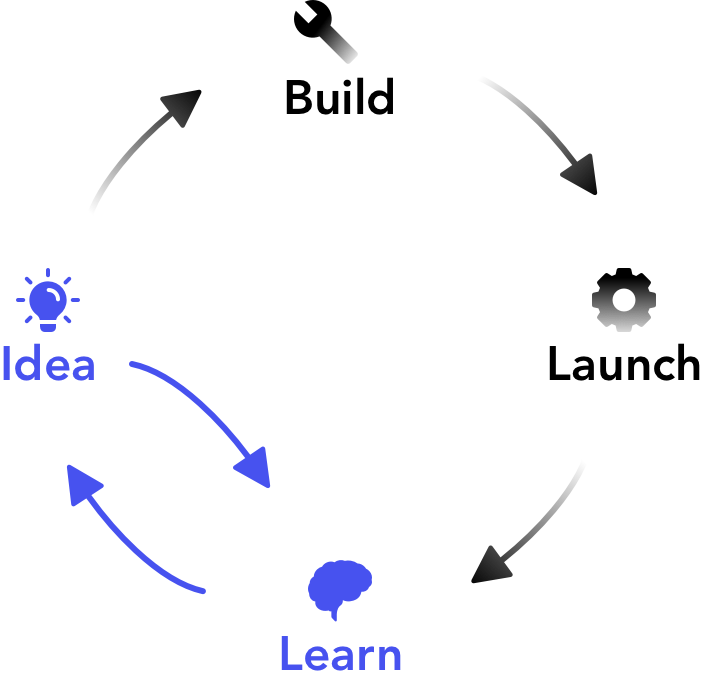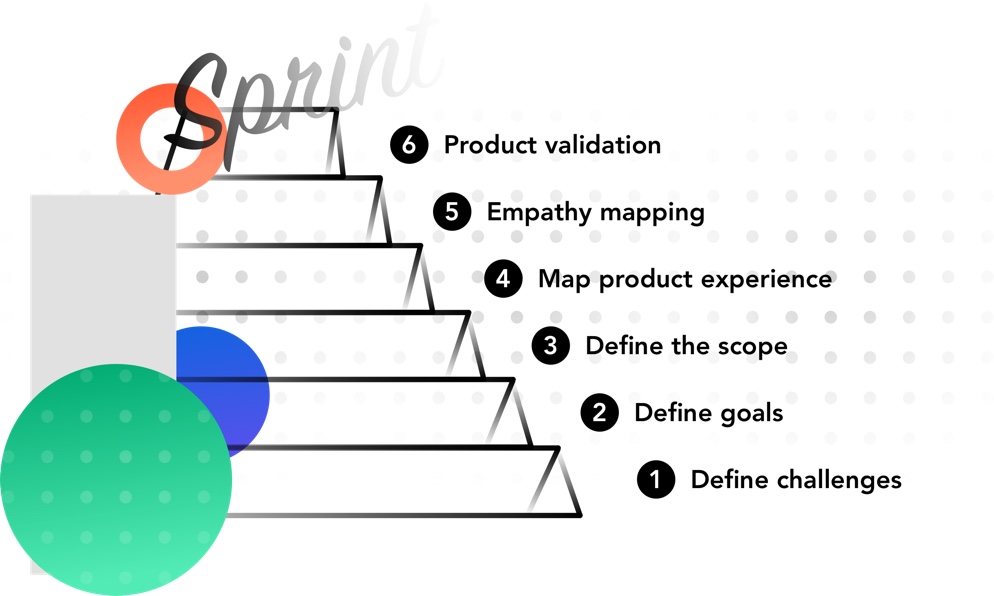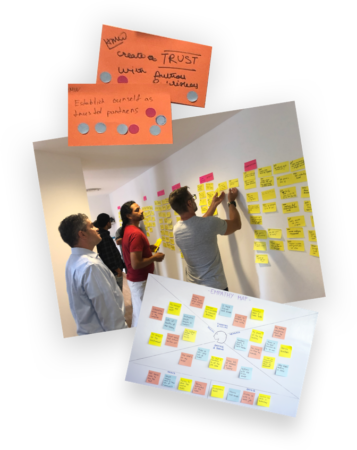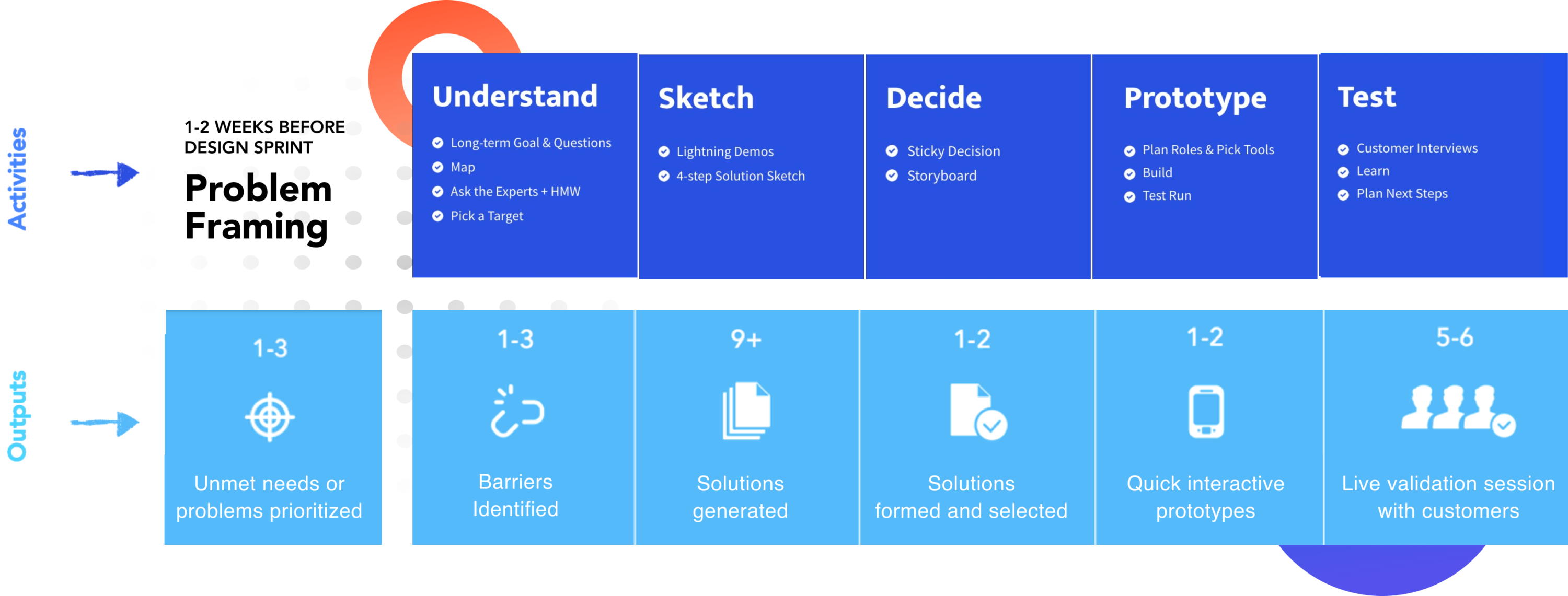How to frame a complete and actionable product vision in 2 weeks with design sprints
In a hyper-competitive software-driven world, you are only as good as your capacity to deliver products that delight your customers -fast. Software runs the world and enterprise products too have to join the “customer-driven” movement.
The days of clunky enterprise product experiences are gone forever as the user takes the driver’s seat for enterprise products as well. Robust, feature-rich, intuitive, secure, and uber-usable are the terms that must come to mind when we say ‘well-designed’.
The pressure to design enterprise products that deliver a consumer-like product experience is rising. Enterprises must figure out how they can deliver such products at light speed without making any compromises. Along with is, the enterprise is now faced with a new challenge –how to define a complete product vision quickly?

Enter Design Sprints
While building products for the enterprise, somehow, great design and agility have seemed like opposing goals due to the focus on time constraints. This does not have to be so.
Enterprise products and applications are usually mission-critical and have to be rolled out faster due to the business impact they can have. The consensus has often been to bake in functionality and performance and sacrifice design at the altar of time constraints. Such products inevitably need to be re-written and re-designed over time to drive up user adoption.
The needs and the complexities of the enterprise products demands a new approach to framing product vision.
Design Sprints, a concept popularized for Google to build consumer products, can be employed in the enterprise context, albeit with a few tweaks, to design highly functional products that drive adoption and help the users reach their end goals with ease while imposing a minimal cognitive load on them.
This is how we use Design Sprints to help our enterprise customers define a rich product vision that delivers value to their end-customers, while still staying ahead of the clock.
Measure twice, cut once – Enterprise products need a planning redesign.
The Design Sprint process helps to discover what the product vision should be. It almost acts as a prototyping process that allows organizations to test their product idea with “real” users before any development begins. This is done keeping the criticality of enterprise use-cases and the complex enterprise environment in mind.
Our Design Sprint process helps organizations frame a product vision in two weeks by gathering user-focused insights, prototyping ideas, and validating them. At the end of the two weeks, you have a validated and fleshed out product vision that is ready to take the next steps towards development. This process involves a rigorous assessment of all the moving and static parts of enterprise product design, user needs, product objectives, etc. to provide a clear roadmap for product development to help organizations build products that end-users will actually use.

Design Sprint – How we do it
Our Design Sprint workshop starts with an intensive one-week effort aimed at solving this exact problem by building a shared understanding of the product vision with all the stakeholders by developing problem awareness, providing clarity, and removing all ambiguity. It is only upon gaining complete clarity on completion of this process that we proceed to the actual product design phase.
The Design Sprint workshop is the most critical stage of product development. Getting the Design Sprint right will result in a better-informed product vision and an actionable and measurable plan. Getting it wrong will lead to chaos and confusion later on that could stall product evolution.
Our Design Sprint workshop brings all the stakeholders under one roof to go through a series of well-defined, calculated, and tested steps during the first week. The workshop should include the technologists who will be developing or managing the products, leaders and business unit heads who feel their clients or employees need the product and anyone else who will be impacted by the product.
We create small groups of 7-9 people led by one design specialist to get the Design Sprint process moving. The objective behind creating small groups is to ensure greater participation, receive and share more ideas, and have everyone directly invested in the process of product creation.
We also conduct structured interviews with the stakeholders, pose the right questions, and direct them so that everyone invested can relate and understand the information presented.

Stage 1: Define challenges to build problem understanding
In the enterprise context, new product development or product evolution happens to solve a pressing problem. Getting the relevant stakeholders under one roof helps to evolve a shared definition of the problem statement to identify the core purpose of the product. Why is the product necessary? Who will use it? How will they use it? What benefit will it bring to the table?
Our Design Sprint gets answers to these and other pertinent questions related to the product and the end-goal of the user within carefully designed sessions. The first four days of the workshop are organized methodically to ensure that by the end of these we have a fully fleshed out product vision. Each day has a clearly defined agenda and is conducted with the relevant set of people.
The initial two days are spent with the entire team to discover, map, emphasize, sketch and create the product. The Windmill team then takes one day to create a prototype which is then shared with the stakeholders and users on day 4 to test. The product summary is then drawn, and the ensuing days are spent creating a robust, well-designed working product vision and its relevant documentation.
The knowledge pooling and interviews conducted in this round ensure that everyone is on the same page and helps to secure the elusive ‘buy-in’ that is essential to ensure successful collaboration.
It is almost like following the Yellow Brick Road to reach the Wizard of Oz, as everyone contributes their unique viewpoint to build a stronger overall product vision.
The Design Sprint delivers not only a workable vision of the product but also sets the ground for more predictable and efficient product design.
Stage 2: Define goals for clarity and transparency
Since we can only manage what we can measure, it becomes important to set the parameters for measuring success. Well-defined goals provide greater clarity and transparency to the product vision process, help all stakeholders be on the same page, and highlight all the important milestones that need to be covered to tick off things as ‘done’.
Stage 3: Define the scope to design a clear roadmap
Since a goal without a plan is just a wish, it becomes equally essential to define a clear project development roadmap. This involves considering all the goals and identifying the key priorities. During development, teams will then save time and create more viable product prototypes as they have clarity on which features, functionalities, and interfaces they need to develop first and which can be pushed later into the development cycle.
Stage 4: Map product experience to match the customer experience
Enterprise products have to now be by the people, for the people so, it is essential to know your audience inside out to drive elevated customer experiences.
Hence the next stage of the Design Sprint process involves gaining a thorough understanding of the target audience, understanding their motivations behind using the products and evaluating the stages they go through to reach their end-goal.
Stage 5: Empathy mapping to drive adoption
Empathy mapping is a critical step in our Design Sprint process. Empathy mapping helps the invested stakeholders take a deep dive into specific user journeys that are fundamental to the product functionality and essential to provide the desired product experience.
It accounts for all the feelings and associations that end-users experience while performing their tasks. It also takes into consideration the existing user journeys to design how they could ideally look. This approach helps in customizing optimized and elevated user journeys that delight and drive product adoption.

Stage 6: Product validation to save time and costs
Upon completion of these stages, the project moves to the product validation stage. At this stage, the product is tested with the “users” to gain clear validations and improvement ideas. Validating the product with the user helps in eliminating risk by building a solution that resonates with the users. Organizations end up saving months of development time and money that can then be directed to other ideas.
How does Design Sprint drive value?
Our Design Sprint process not only helps organizations build a robust product, but also educates them on how teams can solve problems by leveraging collaboration, mutual listening, and trust. Of course, delivering this impact is not easy. We have to undertake a lot of pre-research before undertaking a project to drive a productive workshop. This workshop needs complex facilitation skills, a clear understanding of the impediments in the enterprise landscape such as stakeholder availability and identifying the right projects to facilitate – whether it is new product development or a product improvement or modification.
Getting every stakeholder to contribute and participate in the process of creation of the product vision also enables a harmonious adoption of the solution. These people become product advocates and drive product adoption across the enterprise.
The process of defining a rich product vision also helps organizations get clarity on their product ecosystem. Often organizations have an idea or a vision of a product. But this idea might not necessarily address the complete picture and all the moving parts that go into making a robust product.
Such a Design Sprint process can help organizations get clarity on what the product vision should look like and the important areas that they need to focus on to quickly launch products that enterprise product users love.





